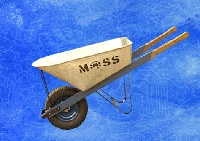A wheelbarrow is essential equipment for any gardener or handyperson, but which is the right one for you? It is important to feel comfortable when using the barrow. Here are a few guidelines.
Shape: There are three shapes of wheelbarrow available – the home gardener shallow-tray variety, the builder’s barrow, and the squaretray utility barrow.
Materials: Three different materials are available for the tray – galvanised, painted (powder coated) or polythene plastic. Galvanised is preferable to non-galvanised as it lasts much longer. Painted may look smart but is soon scratched leading to rusting of the tray. This is particularly important when barrows aren’t in constant use or may be left standing with wet material in them. Plastic trays are much lighter, although you would need to be careful if throwing sharp or heavy objects into them. They are good for corrosive loads such as fertilisers and animal manures but if left out in the weather they may only last 5 years. They are popular for concreting.
Handles: We found that most of the handles are poorly designed with such problems as uncomfortable thin plastic covers which can slip off leaving you holding the handle as the barrow takes off. Others, especially in the builders range were so thick that the average person couldn’t get a proper grip. Sculptured timber handles (as in the recommended Moss and Daytek) are preferable where the handle is thinner at the grip and wider at the end of the handle.
Tyres: Always choose a pneumatic (pump up) tyre. Solid tyres dig into the ground, and are harder to wheel. Wider tyres and larger wheels are easier to use, will go over bumps better, and are less likely to get bogged. The new extra-wide tyres are a major breakthrough. We strongly recommend these for all applications, especially where wheeling along planks is likely. Also look for thick-walled tyres which won’t suffer punctures from rose or bougainvillea thorns.
Struts: The cross bracing should be on the rear (wheel side) of the supports to avoid the problem of hitting your foot or leg on them when wheeling.
Size: A good quality galvanised builder’s barrow with a deep tray is well balanced when carrying a heavy load, because most of the load is straight over the wheel. Smaller barrows with a thin frame which are presumably designed for women or older people are actually harder to manoeuvre. If the tray is shallow, the load can spill straight out when you are wheeling it along. Regardless of a person’s sex, age or size we found the larger builder’s barrows the easiest to use.
Tray: Seamless steel is best for added strength, and won’t trap dampness. The Moss barrow has seams but is galvanised dipped after manufacturing. Most builder’s barrows have a base plate under the tray for extra support.
Tipping Guard: Watch out for this, it can stop you emptying the full load, and can catch on objects as you wheel it along.
Two-wheeler barrows: These low-to-the-ground carts may be easy to load but are very difficult to drag around and are not recommended for serious gardeners.
Burke’s Backyard Top Three Barrows
1. Moss – Standard Galvanised with wide wheel
Large capacity builder’s barrow
RRP $212 (outside NSW an extra freight charge may apply)
Weight 32kg
Available from Builders and Bricklayers suppliers in QLD, NSW, VIC and SA. For nearest supplier contact Keith Moss Pty Ltd on (02 ) 9725 5477.
2. Daytek – The Tradesman in galvanised finish
RRP $129
Weight 21kg
Available from leading hardware stores throughout Australia.
3. Kelso – Master Builder with black polythene tray and with optional wide wheel
RRP $256
Weight 18kg
Available from leading hardware stores throughout Australia.
Further reading
For more information on using wheelbarrows see the article in the September issue of the Burke’s Backyard magazine on pages 108-109.



